Sunday, October 05, 2008
ON HIDALGO, BUSTAMANTE AND AMBETH OCAMPO

This painting, Assassination of Governor Bustamante by Felix R. Hidalgo, is currently undergoing restoration at the National Art Gallery. It was the main focus of Ambeth Ocampo's lecture -- Hidalgo, Bustamante and the Big Black Wolf -- held yesterday at the museum's Ablaza Hall.
It was a riveting two-hour lecture in which from the painting, Ocampo traced the history of the story of Governor Bustamante who was assassinated by the friars during the 18th century and how it spawned the novel La Loba Negra (The Black Wolf) previously believed to have been written by Fr. Jose Burgos, but now proven to be a forgery.
This was the first time I had attended a lecture conducted by Ambeth Ocampo, and I must admit I was spellbound, and now eagerly await the next, which I hope should be in the very near future. I have read many of his books -- sources of numerous blog articles -- and although I am one of those who never asked for autographs (from any of the many film and music artists I had met or run into in my life), yesterday I deemed an exception -- an altogether different situation. Compared to other artists, I think authors loved it most when knowing about or meeting those who actually appreciate their writings.
Hence, there wasn't any trace of trepidation on my part yesterday when I approached Ambeth Ocampo prior to the start of his lecture -- to introduce myself as a big fan while deftly whipping out two books from my bag for him to sign. He was indeed delighted to oblige.

I very much appreciate my articles and photos appearing on fellow bloggers' sites, popular broadsheets, and local broadcast news segments, but I would appreciate even more a request for permission first.
Thank you!
*
Visit: MANILA PHOTOJOURNALISM
a work in progress
*
Labels: Ambeth Ocampo, art matters, Featured artist, Philippine history
posted by Señor Enrique at 7:00 AM
| 38 comments
![]()
![]()

Saturday, October 04, 2008
ARTISTS' FLEA MARKET AT CUBAO EXPO

In case you haven't any thing special planned for this weekend, you may want to check out the Cubao Expo Artists' Flea Market -- going on since Friday, October 3 until tomorrow, Sunday -- from 2 pm until midnight. Evening live music performances are provided as well for everyone's enjoyment.
Our fellow blogger, artist Palma Tayona, is participating in this event to sell some of his old drawings -- ranging in price from 200 to 3,500 pesos -- as well as children's books he had designed, including canvas tote bags and wallets that bear images of his old study priced from 100 to 315 pesos.
For refreshments and delectable treats, this bohemian enclave boasts of a few funky bistros, including the Italian restaurant Bellini's.
For more information and to see a map of Cubao X, visit Visual Viscera.
* Refresh screen to replay slide show!
An Artist in Libertad
I very much appreciate my articles and photos appearing on fellow bloggers' sites, popular broadsheets, and local broadcast news segments, but I would appreciate even more a request for permission first.
Thank you!
*
Visit: MANILA PHOTOJOURNALISM
*
Labels: art matters, events, Featured artist
posted by Señor Enrique at 5:22 AM
| 28 comments
![]()
![]()

Monday, August 21, 2006
BONIFACIO AND THE CRY OF BALINTAWAK
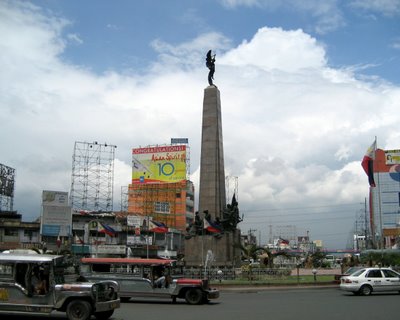
It has been said that we Filipinos have no sense of history. However, according to Ambeth Ocampo, it isn’t so much as indifference or amnesia, but rather our uncertainty as to what or whom to believe. Thus, the easy way out is to simply ignore the past.
Take for instance Andres Bonifacio); how much do we really know about him, as well as his group, KKK (Kataastaasan Kagalanggalangang na Katipunan ng mga Anak ng Bayan)?
To avoid an exhausting historical treatise, Ocampo suggested that we simply look at the world of local art and study how Bonifacio is represented by Filipino artists in the last eighty years in their drawings, paintings, music, and sculpture. He argued that the stereotyped image of Bonifacio as represented in their works goes against historical documentation. Hence, we have two Bonifacios in our national consciousness — one mythical, the other real — and that the myth has become more popular than reality. And therein lies our problem.
As an example, Ocampo pointed out when a sculptor submitted studies for a proposed Bonifacio monument to the National Historical Institute. From his awkward drawings revealed the popular Bonifacio stereotype: one wearing an open camisa de chino to display a muscled chest and pants rolled up to reveal bare feet. On his left hand waved the Katipunan flag, while his right raised a menacing bolo. To highlight this difficult pose, the artist gave Bonifacio fiery eyes and a silent but suggested rebel yell.
To the masses, there is nothing wrong with this image of Bonifacio. It can be seen in full color in the Carlos V. Francisco mural at the Manila City Hall, or in the various cement versions in schoolyards and municipal plazas all over the archipelago. Everything seemingly comes from the same mould or idea.
Ocampo traced the origin of this image to a drawing by Jorge Pineda reproduced on the cover of Renacimiento Filipino of July 14, 1911. From this drawing was born the monument by the sculptor Ramon Martinez, which was unveiled on September 3, 1911, in Balintawak (it has since been transferred and now stands in front of Vinzon Hall in U.P. Diliman).
Thus, that has been how most remembered Bonifacio until it was challenged by the late National Artist for Sculpture Guillermo Tolentino.
After painstaking research and interviews with people who had actually known Bonifacio, Tolentino created a masterpiece in bronze in Caloocan that has become a landmark now known as “Monumento.”
In this monument, as Ocampo illustrated, the artist represented a different image of Bonifacio: one in a closed barong tagalog, with a handkerchief tied on his neck, and wearing shoes! He stands calm but defiant with a bolo in one hand and a gun on the other. Behind him are Emilio Jacinto and a standard bearer with the Katipunan flag.
When the protests poured in, Tolentino countered his critics with his research. The likeness was based not only on a photograph of Bonifacio, but on the bone structure of his sister Espiridiona as well. Interviews with surviving members of the Katipunan gave an idea of his attire and revealed that, contrary to common belief, Bonifacio favored his gun over his bolo in battles. Tolentino even consulted espiritistas (psychics) to discern the true likeness and character of Bonifacio.
Ocampo also cited Bonifacio’s likeness to be elusive, for there is only one faded studio photograph of him in existence as compared to Jose Rizal’s numerous pictures. The irony of it all is that despite the common image of Bonifacio as the barefoot Great Plebian in his camisa de chino and rolled up pants, our sole photograph of him shows him wearing, of all things, a coat!
Aside from Bonifacio’s image, there was also the confusion as to the authenticity of the Grito de Balintawak tradition. Since the turn of the century, it has been widely believed that the first cry of the revolution took place in Balintawak, Caloocan. Then along came Teodoro Agoncillo, our nationalist historian, who gave the exact date for the cry as August 23, 1896, and the exact place to be Pugadlawin, not Balintawak. Despite these becoming textbook facts, according to Ocampo, the Balintawak tradition continues to thrive. And that even Nick Joaquin wrote in support of Balintawak.
This controversy remains unresolved except in our textbooks, but as Ocampo pointed out, depending on the book one should read, there were five dates for the Cry — August 20, 23, 24, 25, and 26 — and five different venues: Balintawak, Pugadlawin, Kangkong, Bahay Toro, and Pasong Tamo. Ocampo, to this day, remains confused and stumped himself.
Source: Bonifacio’s Bolo by Ambeth R. Ocampo
Labels: Featured artist, historical figure, Philippine history
posted by Señor Enrique at 8:27 AM
| 17 comments
![]()
![]()

Saturday, July 29, 2006
People I Admire: GEORGE GERSHWIN
 Hailed as one of America’s important composers, George Gershwin (1898-1937) along with his brother, Ira (1896-1983), collaborated to create timeless music for some of Broadway’s remarkable musicals – Lady Be Good, Strike Up The Band, Showgirl, and Funny Face. There was also their folk opera Porgy and Bess which produced the hit song, Summertime, as well as George’s orchestral works, Rhapsody in Blue and An American In Paris.
Hailed as one of America’s important composers, George Gershwin (1898-1937) along with his brother, Ira (1896-1983), collaborated to create timeless music for some of Broadway’s remarkable musicals – Lady Be Good, Strike Up The Band, Showgirl, and Funny Face. There was also their folk opera Porgy and Bess which produced the hit song, Summertime, as well as George’s orchestral works, Rhapsody in Blue and An American In Paris.His music had become classic standards and no respectable jazz artist would be without a Gershwin in his repertoire. Balladeers from Frank Sinatra to Tony Bennet, as well as song stylists from George Michael to Rod Stewart had delved into the Gershwin catalog. And filmmakers like Woody Allen had used Gershwin's orchestral work as soundtrack to his film Manhattan.
His songs — such as ‘S Wonderful, Our Love Is Here To Stay, Someone To Watch Over Me, Nice Work If You Can Get It, and But Not For Me — will remain forever etched in most music lovers’ hearts.
According to Jane Erb’s biography of this great American composer, “He never experienced a dry spell or the composer's equivalent of writer's block, and he was equally adept at composing music to which words were added or fitting music to book and lyrics already written, as he did in Porgy and Bess.” And always a self-promoter, “He loved nothing more than parties where he could (and did) monopolize the evening at the piano, playing and singing his own works for the friends who adored him.’
George Gershwin (named Jacob Gershovitz at his birth on September 26, 1898) was the second of four children born to Morris and Rose Gershovitz, Russians who had immigrated to New York and married in America. He died on July 11, 1937 of brain tumor.
Photo credit: Bellevue Chamber Chorus
Note:
I thought posting an entry about George Gershwin would be a fitting tribute to this legendary American composer and to commemorate my father's death anniversary today. My father adored Gershwin's music immensely -- both in standard and jazz forms. Suffice it to say, it was Gershwin's music that marked my introduction to jazz while growing up. When I started singing as a youngster, my father played me Frank Sintra’s recording of Someone To Watch Over Me and asked me to learn it. Since his death, every time I find myself alone and in desperate situations, I would sing this song to myself to alleviate my anxiety.
My most favorite version of this song is the one recorded by Heb Alpert as sung by him and embellished with his haunting trumpet solo.
Labels: Featured artist, Growing up memoirs
posted by Señor Enrique at 9:09 AM
| 11 comments
![]()
![]()

Thursday, June 29, 2006
Featured Artist: ENRIQUE TABUENA
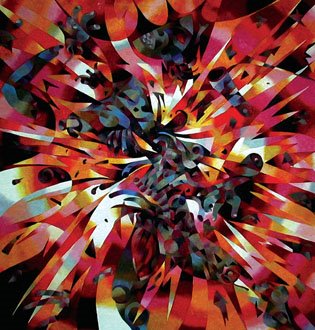
Out of courtesy, I'd usually first ask the artists and photographers for their permissions prior to posting their works on my site. However, in this case with Enrique (Eric) Tabuena — since he didn’t include his email address on his profile at Tabuena Art Central nor allow comments on his entries — I’m just going ahead with it because he has a solo exhibition coming up soon and I’d like you all to know about it.
His show, Woman is in the Details, features 35 artworks from his new collection of oil on canvas paintings. It will be held at Galerie Astra at LRI Business Plaza in Bel-Air 2, Makati from July 7 to July 21.
I first heard of, or should I say from Eric when he posted a comment on one of my blog entries a while back. I’ve become a regular visitor to his site ever since; always enchanted by his paintings. Last week, planning to feature one of his works, but not knowing that much about him, I googled E. Tabuena and came across Tata Botata’s blogsite entry about him.
Eric Tabuena happened to be the art director to whom Tata Botata, a graphic artist, once reported to. Tata was surprised to have discovered that his boss at the agency has a blogsite. He then went on to discuss Eric’s techniques with his artworks, as well as give him credit for having encouraged him to start his T-shirt designing business.
Having gone to a number of art exhibitions — which showcased some of our upcoming local artists — at SM Megamall’s Artwalk, as well as those over at Edsa Shangri-la Plaza mall, I must admit nothing has captured my imagination as much as Eric Tabuena’s artworks.
Two of my favorites are Sambulat (featured above) and Magic Flute. Both I find cerebral. Engaging.
One the Net: Hiraya Gallery: Enrique Tabuena
Labels: Featured artist
posted by Señor Enrique at 8:59 AM
| 5 comments
![]()
![]()

Tuesday, March 28, 2006
DO THE STRAND

This is a picture of a giant panda — magnified 50000 times — painted on a single strand of human hair by Chinese micro-painter Jin Yin Hua. It took the artist ten days to create the mini-masterpiece using a single rabbit hair as a paintbrush. Gallery visitors who wanted to view the tiny painting had to look through a microscope.
Click here to see his other tiny paintings on human hair.
Labels: Featured artist
posted by Señor Enrique at 7:06 AM
| 4 comments
![]()
![]()

Friday, March 24, 2006
Master Filmmaker: AKIRA KUROSAWA
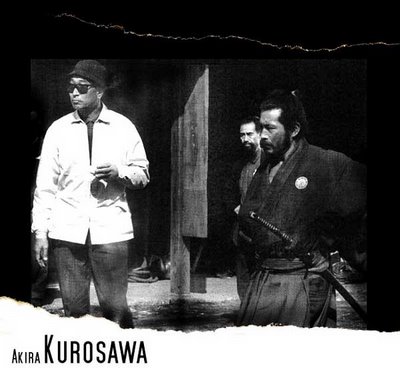
I was happy for Ang Lee when he won this year’s Oscar for Best Director. Hopefully, he will open the door for other Asian filmmakers — including Filipino directors and cinematographers — to get major projects in Hollywood much like what Sidney Poitier has done for African-American actors.
Nonetheless, before Ang Lee, in the realm of Asian filmmakers, there was the acclaimed Akira Kurosawa whose films — such as Rashomon (1950), Ikiru (1952), Seven Samurai (1954), The Throne of Blood (1957), Kagemusha (1980), and Ran (1985) — greatly influenced major filmmakers worldwide from Sergio Leone to George Lucas.
Kurosawa went to art school and favored Western style painting. Although a recipient of many important art awards, he gave up the brush to pursue filmmaking. Starting in 1936 until 1943, he worked as an assistant director for Yamamoto Kajiro, one of Japan’s major directors of war propaganda films. Kurosawa initially gained fame as an excellent scenarist, but some of his best scenarios were never preserved on celluloid; only published in journals. Just the same, they were recognized and awarded notable prizes for their freshness of representation. In 1943, Kurosawa was promoted to director and made his first feature film, Sanshiro Sugata. That was the beginning of his illustrious career as a major and influential film director.
An entry about Kurosawa in Encyclopedia Britannica Online mentions that Kurosawa’s films “represent a unique combination of elements of Japanese art—in the subtlety of their feeling and philosophy, the brilliance of their visual composition, and their treatment of samurai and other historic Japanese themes—with a distinctly Western feeling for action and drama and a frequent use of stories from Western sources, both literary classics and popular thrillers.”
Other than for his excellence in filmmaking, Kurosawa also gained notoriety for sparing no expense when it came to providing excessive quantities of high quality gourmet food and exotic delicacies on the set for his entire cast and crew.
Labels: Featured artist, films
posted by Señor Enrique at 7:43 AM
| 8 comments
![]()
![]()

Wednesday, March 15, 2006
Hopeless Romantic: BRYAN FERRY

I was pleasantly surprised one hot summer afternoon when my best friend called to ask if I wanted to see a concert at the Academy of Music by the English rock group, Roxy Music; he had an extra ticket, because his friend from school he originally planned to go with was unable to make it. I said sure.
I went without knowing anything about this group, but then again, that’s basically how it goes in New York at any given season. With so many happenings, it's virtually impossible to keep abreast of everything. In the music scene alone, from the city's grand halls to the seedy hole-in-the-wall downtown bars, there's always a gig somewhere that's worth checking out. Also, especially when it comes to music, I've always preferred going to a concert with an open mind; unfettered by some jaded critic's opinion.
On this particular evening, though, from entering the Academy of Music until we were seated, I couldn’t help but notice a rather unusual sight: quite a number of females in the crowd were glamorously dressed; somewhat reminiscent of Hollywood's 1940s glitter era. This was supposedly a rock concert for kids who favor T-shirt, jeans and the occasional loose joints. I was astounded. And it wasn’t until Roxy Music came on stage and performed their music that everything made sense to me.
The group exuded an image of veritable charm and glamour while their music echoed nostalgic romance and elusive love. They were absolutely enchanting. I was hooked as a fan from that moment on.
Bryan Ferry was the founder of this glamour rock band whose initial efforts to shop around their demo tapes to record companies were met by a string of rejections. However, the group won the heart of Jon Peel, Britain’s most respected and popular radio disc jockey, as well as the attention of the weekly music newspaper Melody Maker. Their perseverance eventually paid off when they were signed by EG Management.
When their debut LP was released, much to the chagrin of their detractors, Bryan Ferry, Brian Eno, Andy Mackay, Paul Thompson and Graham Simpson — collectively known as Roxy Music — became overnight stars. Theirs was the most stunning and stylish music; ushering in Britain’s New Wave music phenomenon.
According to Wikipedia, “the group is noted for their combination of idiosyncratic experimentation and sophisticated wit, evident in their literate lyrics, restrained instrumental virtuosity, and highly developed visual presentation (mainly directed by Ferry) which expropriated imagery from the realms of high fashion and commercial photography.”
During the ensuing years, Bryan Ferry also pursued solo recording and concert projects. He became even more popular when one of his songs, Slave to Love, was featured in the movie, 8 ½ Weeks. In June 23, 1977, he performed his first New York solo concert at The Bottom Line with Chris Spedding on guitar; the show was opened by Talking Heads. This particular event became the impetus in my working in the music industry.
There were many songs produced by Roxy Music and Bryan Ferry, but if I had to choose only one as favorite, it would have to be Avalon.
Photo Credit: London Lee
Labels: Featured artist
posted by Señor Enrique at 7:47 AM
| 4 comments
![]()
![]()

Wednesday, March 01, 2006
SPENDING THE NIGHT TOGETHER IN SHANGHAI
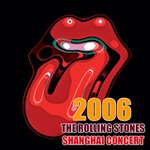
Convinced that the ‘60s bad boys of rock are no longer able to pollute the spiritual consciousness of the country’s young, China’s culture commissars finally allowed The Rolling Stones their mainland debut concert in Shanghai this coming April 8th.
The Stones had once planned to perform in China in 2003, but cancelled due to the SARS scare. Back then, according to Reuters, China’s Ministry of Culture told the band it could not perform four songs -- "Let's Spend the Night Together," "Brown Sugar," "Honky Tonk Women" and "Beast of Burden."
Although no specific reasons were given, it was assumed those songs’ sexually explicit lyrics were the culprit; highly likely, the group will neither play those songs at the upcoming concert so as not to offend the Chinese government.
According to Emma Entertainment, which handles the ticket sales for the British rockers' Shanghai Grand Stage performance, prices will set you back between $37 and $373.
On a side note: I saw the Stones once in Madison Square Garden; Stevie Wonder opened the show. The promoters asked the fans to mail in—as many as they wished—a postcard with his name, address and phone number listed on it. If you were lucky enough to have yours picked out, you get the chance to purchase two tickets. This was done to prevent a bunch of kids from camping out on the grounds of Madison Garden days before the tickets went on sale. I forgot how much I paid for the tickets.
Labels: Featured artist, music
posted by Señor Enrique at 8:05 AM
| 0 comments
![]()
![]()

Friday, February 03, 2006
THE OTHER ROY LICHTENSTEIN

Something you may not know about Roy Lichtenstein: his fascination for America’s Old West, especially with American Indian art. It is evident in his earliest works, as well as in his Surrealist series created during the ‘70s. These were kept at the backburner by Lichtenstein and his dealer, Leo Castelli, because they preferred the public to remain focused on his signature Pop style.
At the artist’s show at Montclair Art Museum, Roy Lichtenstein: American Indian Encounters, a group of Indian-themed Lichtensteins are on exhibit along with Indian artifacts from the museum's own holdings, including a few of the books from the artist's own collection that inspired him.
The show was produced by Gail Stavitsky, the museum's chief curator, and Twig Johnson, its curator of Native American Art, in conjunction with the Roy Lichtenstein Foundation.
Roy Lichtenstein: A Pop Artist's Fascination with the First Americans
An art review by Grace Glueck, The New York Times
Art credit: Estate of Roy Lichtenstein - Private Collection
Title: "End of the Trail," © 1952
Artist: Robert Lichtenstein
Labels: Featured artist
posted by Señor Enrique at 6:30 AM
| 2 comments
![]()
![]()

Wednesday, February 01, 2006
THE TROUBLED DIVA

She was discovered by an artist & repertoire executive of Arista Records who trailed her New York nightclub performances. He saw enormous potential in her and begged his company’s busy top honcho, Clive Davis, to see her. He relented; thus, a special showcase was arranged at Sweet Waters, a club on Seventh Avenue South in New York’s Greenwich Village. Suffice it to say, Clive Davis was immediately won over by her incredible talent; signing her to a lucrative record deal. This was in 1983.
Whitney Houston’s voice was as utterly beautiful as her persona. She was flawless; a rare African-American artist who immediately crossed over the R&B/dance genres to become the ‘80s newest pop sensation. Multiple awards were showered upon her by the music industry. She also became a role model and a most emulated fashion icon. She had the world in her hands. At the height of her career, she sold millions of records while her films grossed hundreds of millions of dollars. She became phenomenally rich in the process.
She married Bobby Brown four months before her debut film, The Bodyguard, was released. Soon thereafter, allegations of drug abuse and marital problems began to emerge. Her adoring fans quietly suspected a life taking a different path; a turn for the worse.
Prior to the release of her fifth record album, Just Whitney, she appeared at an interview with Diane Sawyer, which aired on ABC’s 20/20 newsmagazine TV show. It was the highest-rated interview in the history of American television. Drug use and marriage issues were discussed, but she was evasive and seemed agitated. However, her appearance and demeanor were far more revealing; she was evidently high on drugs during the interview. From that moment on, she slipped downhill with drug-related arrests and trips to the rehab. It eventually became public knowledge that Whitney has been harboring deep-seated problems for which drugs and alcohol were the anesthesia of choice to alleviate her pains.
Recently, the Houston Herald, citing National Enquirer as its source, reported Whitney is back to doing drugs. She was photographed inside a convenience store at 4 a.m. in Atlanta looking strung-out and disheveled; appearing more like a destitute bag lady than a diva that she once was. It went on to report that “Whitney’s voice is shot from years of cocaine abuse and she and her hubby, Roxbury homey Bobby Brown, are running out of money. The newspaper claims Houston, who underwent rehab at least twice since confessing on TV three years ago she had used cocaine, pills and booze, has blown through her fortune buying drugs and supporting a posse of hangers-on. And because she cannot record, no new cash is coming in.”
Regardless of her current predicament, I remain optimistic she will one day resolve her inner turmoil, surmount the setbacks, and come out of it all as an even greater spirit than ever before. And we will all be the better for it, for we shall once again immerse ourselves in the wondrous beauty of her voice. She is an ethereal diva who, unfortunately, has been flying too close to the ground.
Labels: Featured artist
posted by Señor Enrique at 7:27 AM
| 2 comments
![]()
![]()

Thursday, January 19, 2006
GLAMROCK’S UNDISPUTED DIVA

Annie Lennox, as a child, attended a school for the exceptionally intelligent and was later on educated as a classical musician; studying the flute at the Royal Academy of Music in London.
She joined David Stewart as a singer for the Eurythmics after three years as lead singer for The Tourists. She left Eurythmics in 1990 and began her equally successful career as a solo artist. Her 1992 LP, Diva, attained phenomenal critical and commercial success.
She has since followed it up with two more albums, including rejoining Dave Stewart for the recording of Peace LP. She won the Academy Award for Best Song in 2004 for "Into The West” from the film The Lord of the Rings: The Return of the King.
Photo credit: musikbase.de
Labels: Featured artist
posted by Señor Enrique at 8:37 AM
| 2 comments
![]()
![]()

Saturday, January 07, 2006
Art Terrorist: BANKSY
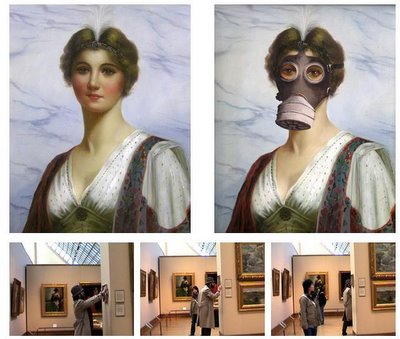
He is Britain’s most notorious “art terrorist” who specializes in sticking fake objects to the walls of major museums and galleries and waiting to see how long it takes for curators to notice. He has been a major source of embarrassment for New York’s The Metropolitan Museum of Art and Museum of Modern Art, as well as the British Museum.
Banksy prefers to remain anonymous due to several pending arrest warrants, but he is believed to be Robert Banks from Bristol. Donning a fake beard, prosthetic nose and hat, he would enter a museum with his modified cheap oil painting and then glues it on a wall. He claims that it’s easier to get forgiveness than permission.
Banksy also believes that in the future we all could be anonymous for fifteen minutes.
Labels: Featured artist
posted by Señor Enrique at 1:20 PM
| 4 comments
![]()
![]()

Thursday, December 08, 2005
THE NIGHT THE MUSIC DIED
It was a night similar to this photograph—Christmas lights adorned some parts of the streets; there were steam coming out of manholes; some buildings’ were gaily lit; and giant billboards featured beautiful women promoting newest trends.
It was nippy outside when I stepped out of my Tai-Chi training center on Sixth Avenue and 43rd Street near Bryant Park. It was really late; they had a special demonstration conducted by a master from the West Coast that featured some of his students. I was compelled to sit through the entire performance; amazed by their disciplined forms and techniques. After which was the courtesy chit-chat with the visitors.
As I headed towards a bus stop on 42nd Street, a man came out of a Blarney Stone bar shouting, “He got shot! He got shot!” A couple of other patrons trailed after him; their faces seemed aghast from the breaking news broadcast that interrupted a football game on television.
I dismissed the commotion and kept walking towards the bus stop thinking the victim might be a Mafia kingpin or some Washington figurehead.
It was a slow night for buses. I must have been standing there for a good twenty minutes when a young couple walked over to wait for the same bus. The guy turned to me and asked if I heard the latest development—that he just lost too much blood to survive. When they told me who it was, my knees weakened; I just sat on the cold curb. The couple knew how grief-stricken I was.
"Damn, Lennon is dead," I whispered to no one.
I grew up in a household of diverse music. My father favored Gene Krupa, Benny Goodman, Cab Calloway, and Xavier Cougat to name a few; my mother loves George and Ira Gershwin, Irving Berlin, and Rogers and Hammerstein; my eldest sister adored Pat Boone, Paul Anka, Doris Day, Patsy Cline, Johnny Mathis and Nat King Cole; my brothers would rock to Bill Hailey, Fats Domino, The Platters, Chubby Checker, Little Anthony and the Imperials and of course, the king; but when the Beatles came along, I immediately declared possession. For the first time in my life, I have music to call my very own.
So, when Lennon died that night it felt as if all music died as well.
He was my idol. I was always amazed by his quick wit, as well as by his courage to speak his mind. When the White House took him on as a nemesis, he fought back just as fiercely. But most important, I was in awe of his words and music. He was to me the finest wordsmith.
The first time I saw him in person was in Manila. He was seated at the back of a white Cadillac; George on his left and Paul on his right. When he noticed me and some friends running towards their car from a distance, he must have asked the driver to slow down a bit to allow us to catch up. He then bent forward and waved at us with a big smile on his face. When we all dropped on the grass as if struck by an invisible force of his gesture, they all laughed—amused by our antics. The white Cadillac then picked up speed, made a u-turn and headed towards the yatch club.
I would run into him many a times since that afternoon; usually around the Upper West Side. On a couple of times inside a café in the 70’s between Columbus Avenue and Central Park West. I would always greet him with, “Hi John!” And just like an old friend he would say hello back while meeting my eyes. That would be it. No small talk, autograph requests or pictures to take. He was considered a neighbor and that was it.
He was always with his baby, pushing his stroller. Inside the café, after giving the baby his bottle or letting him nap, he would lose himself in a book while he sipped his cup of tea or coffee. No one bothered him. Almost all of New York granted him that kind of respect; treating him as an ordinary citizen just out to enjoy the day with the baby. Always, the locals would greet him either with a quick hello or a simple knod of acknowledgement, which he would reciprocate in kind.
Wikipedia’s profile of him claims, “When asked once in the 1960s how he expected to die, Lennon's offhand answer was ‘I'll probably be popped off by some loony.’ In retrospect, although he might have meant it as a joke and did not expect it to happen, the comment turned out to be chillingly accurate. Another chillingly accurate comment was made in his last interview, where he mentioned that he often felt that somebody is stalking him: first it was federal agents in the 1970s trying to deport him and later the obsessed fan in 1980.”
New York has a handful of celebrities as its residents, but none compared to John Lennon in terms of integrity, madness, brilliance and influence. But most striking was his deep longing for peace for all of mankind.
Labels: Featured artist, Life in New York
posted by Señor Enrique at 4:35 AM
| 2 comments
![]()
![]()

Wednesday, November 09, 2005
Featured Artists: A GANG OF FOUR

"My painting is visible images which conceal nothing; they evoke mystery and, indeed, when one sees one of my pictures, one asks oneself this simple question - 'What does that mean'? It does not mean anything, because mystery means nothing either, it is unknowable."
Rene Magritte (1898-1967)
http://www.artchive.com/artchive/M/magritte.html
“The creative act is not performed by the artist alone; the spectator brings the work in contact with the external world by deciphering and interpreting its inner qualifications and thus adds his contribution to the creative act.”
Marcel Duchamp (1887-1968)
http://www.artchive.com/artchive/D/duchamp.html
“All good ideas arrive by chance.”
Max Ernst (1891-1976)
http://www.artchive.com/artchive/E/ernst.html
“An original is a creation motivated by desire. Any reproduction of an original is motivated by necessity. It is marvelous that we are the only species that creates gratuitous forms. To create is divine, to reproduce is human.”
Man Ray (1890-1976)
http://www.artchive.com/artchive/M/man_ray.html
Labels: Featured artist
posted by Señor Enrique at 6:59 AM
| 0 comments
![]()
![]()

Saturday, October 22, 2005
Featured Artist: SHIRLEY HORN
"Horn's taste is impeccable, her conviction contagious, and when she sings a lyric . . . we accept it as pure gospel." - Vanity Fair
Shirley Horn Discography
http://www.jazzdiscography.com/Artists/Horn/shorn.htm
Shirley Horn Biography
http://www.swingmusic.net/Horn_Shirley.html
Shirley Horn, Jazz Singer and Pianist, Is Dead at 71 (by Ben Ratliff, New York Times)
http://www.nytimes.com/2005/10/22/arts/music/22horn.html?ex=1287633600&en=a4fbc4a97e5ddfd8&ei=5088&partner=rssnyt&emc=rss
Labels: Featured artist
posted by Señor Enrique at 2:23 PM
| 0 comments
![]()
![]()

Saturday, October 08, 2005
Featured Artist: TET BAUTISTA
Tet usually includes a brief historical backdrop with his drawings of people of great significance. Very interesting.
Link to Tet Bautista’s blogsite:
http://www.tetbautista.com/blog/
Labels: Featured artist
posted by Señor Enrique at 6:17 AM
![]()
![]()

Wednesday, October 05, 2005
Featured Artist: ROMEO FACTOR

Untitled
Artist: Romeo Factor
Wood Sculpture, Molave
Representation:
Contreras Sculptures
The Artwalk, SM Megamall
contrerasscultures@hotmail.com
Links:
About the Molave wood
http://www.windsorplywood.com/tropical_woods/molave.html
Labels: Featured artist
posted by Señor Enrique at 9:06 AM
![]()
![]()









